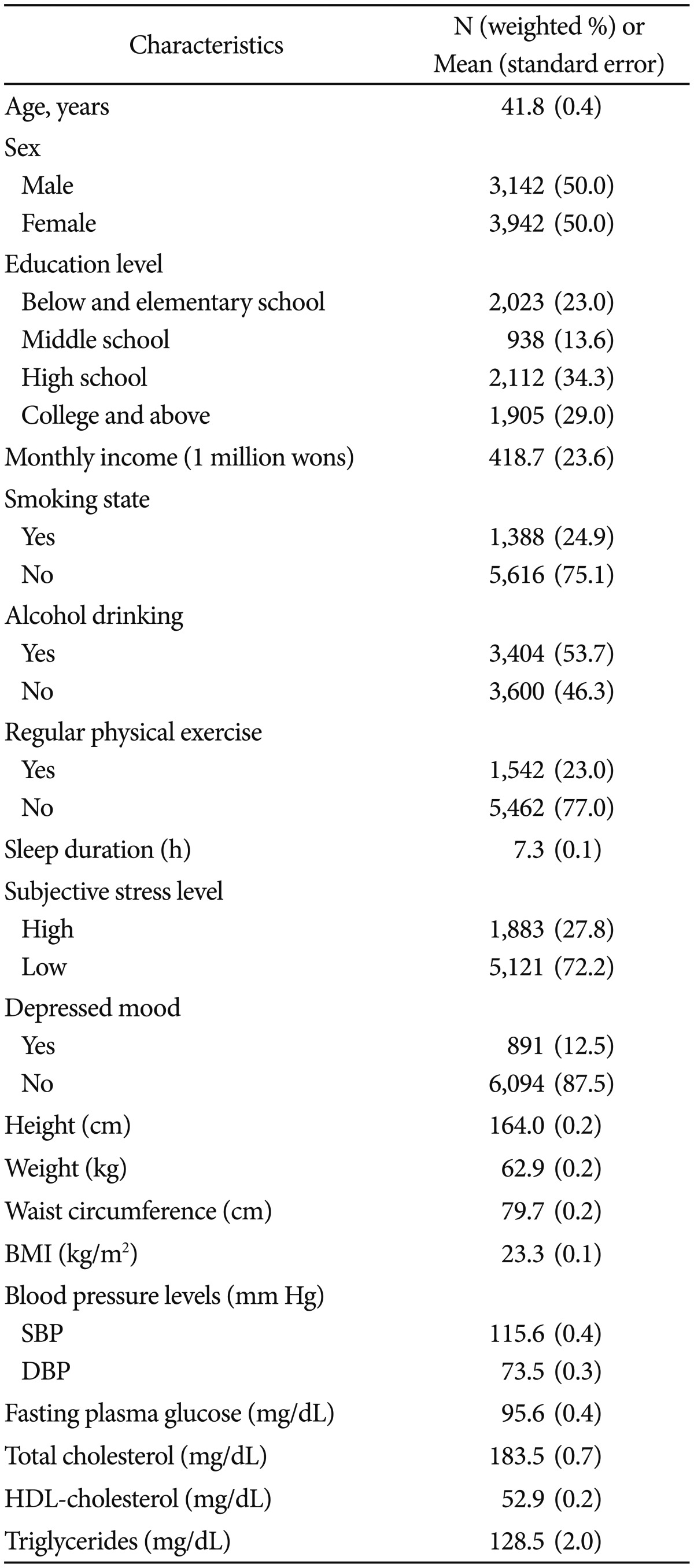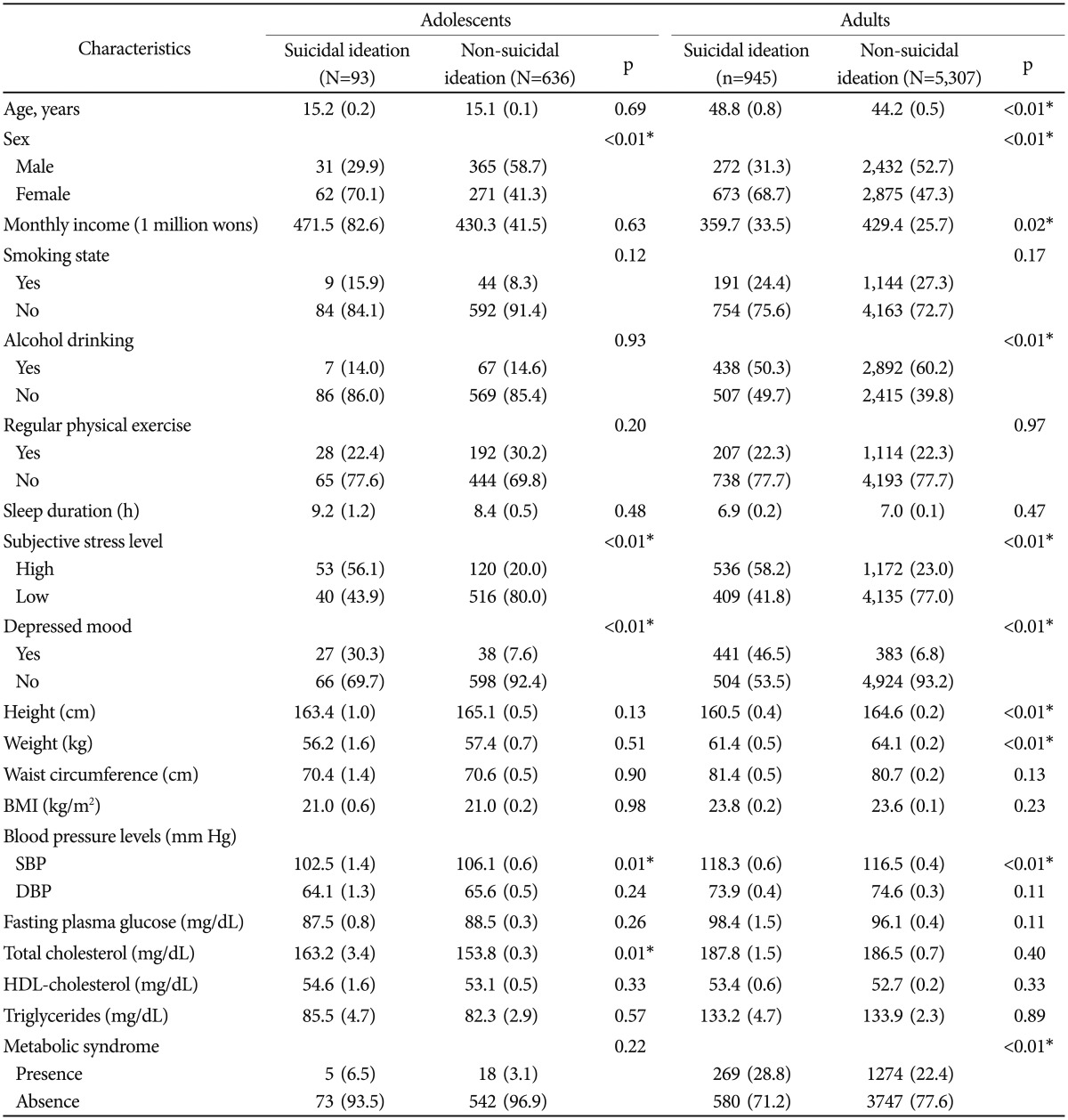Metabolic Syndrome and Suicidal Ideation in Korean Based on the 2010 Korean National Health and Nutrition Examination Survey
Article information
Abstract
The aim of this study was to investigate the relationship between metabolic syndrome and suicidal ideation in Korean. This study was based on the 2010 Korean National Health and Nutrition Examination Survey. A questionnaire was used to measure suicidal ideation and physical examination was performed to measure waist circumference, blood pressure, fasting glucose, cholesterol and triglyceride levels. Complex samples logistic regression was performed to estimate the relationship between metabolic syndrome and suicidal ideation among adults and adolescents. Subjects with metabolic syndrome were more likely to have suicidal ideation in adult. There would be essential needs to evaluate suicidal ideation in adult with metabolic syndrome and to follow up suicidal ideation in adolescents with metabolic syndrome.
INTRODUCTION
In South Korea, the suicide rate is 28.1 per 100,000, which is much higher than the OECD average of 11.3 per 100,000.1,2 According to the 2010 report of Korea Statistics, suicide-related mortality reached 31.2 per 100,000, which was a two-fold increase from 2000 and suicide was the leading cause of death among people in their 10s and 30s in South Korea.2 These statistics indicate that suicide is a growing problem in Korea, especially among the young. Youth suicide results in the loss of productive activity in a social context.3 Suicide is a tragedy to the person's family and friends as well as to the larger society to which the victim belonged.4 The lifetime of prevalence of suicidal ideation in South Korea was 15.2% and unplanned suicide attempters experience suicidal ideation.5,6
Metabolic syndrome (MS) refers to the simultaneous presence of impaired glucose tolerance, obesity, dyslipidemia and hypertension and is a serious health problem globally.7 The incidence of MS is also growing quite rapidly in concert with improvements in the standard of living and lifestyle. In the Korean population, the prevalence is approximately 9-25%.8,9 The prevalence of MS among children and adolescents is approximately 10% and is highly correlated with obesity.10 MS is considered a risk factor for cardiovascular disease and diabetes.11 MS is also related with depression12 and decreased cognitive function in elderly people.13 Thus, MS is related to not only cardiovascular diseases but also poor mental health. But, there are just few study associated relationship between MS and suicidal ideation. This study aimed to determine how MS may be related to suicidal ideation in a Korean based on the Korean representative survey.
METHODS
This study was conducted using data collected by the 2010 Korean National Health and Nutrition Examination Survey14 via a questionnaire and physical examination. The questionnaire was conducted by trained interviewer according to the survey policy using an interview format and asked questions about education and economic activities; for the remaining items on smoking, drinking and physical exercise, respondents completed the survey on their own time. The informed consent was complete in the interview. The physical examinations included measurements, observations and specimen analyses. This survey was conducted upon the approval of the research ethical review board of the Korean Centers for Disease Control and Prevention.
MS was defined based on the 2001 National Cholesterol Education Program-Third Adult Treatment Panel (NECP-ATP III) guidelines along with the waist circumference values for Koreans suggested by the Korean Society for the Study of Obesity.15,16 MS was diagnosed if three or more of the following criteria were met: 1) waist circumference, male ≥90 cm, female ≥85 cm; 2) either SBP ≥130 mm Hg or DBP ≥85 mm Hg or specific medication; 3) FPG ≥100 mg/dL or specific medication for diabetes or previous diagnosis of Type 2 diabetes; 4) HDL-C, male <40 mg/dL, female <50 mg/dL; and 5) TAG ≥150 mg/dL or specific medication. When it comes to MS in adolescents, cut-off values, which were modified for adolescents based on the 2001 NECP-ATP III criteria, were used.15 Waist circumference, blood pressure and gender percentiles of the 2007 standard measures for Korean children and adolescent were also used as a reference.17 MS was diagnosed if three or more of the following criteria were met: 1) waist circumference ≥sex, and age-specific 90th percentile; 2) either SBP or DBP ≥sex, age and height-specific 90th percentile, use of blood pressure-lowering medication or a previous diagnosis of hypertension; 3) FPG ≥100 mg/dL, current diabetes status or current use of insulin or hypoglycemic medication; 4) HDL-C ≤40 mg/dL; and 5) TAG ≥110 mg/dL.
When it comes to suicidal ideation, respondents were asked if they had thought of suicide over the last year, to which they responded 'Yes' or 'No'. Age, sex, education level and monthly household income were included. To assess the depressed mood, respondents were asked if they felt persistently sad or hopeless to such an extent that their everyday life was affected for two weeks or longer over the last year to the extent their daily life was affected. Respondents were asked whether they experience stress in their daily lives. Response choices ranged from "never or a little" to "often or very often." Smoking, drinking status, sleep duration and physical exercise were investigated. Height and weight were measured to compute their BMI. Their waist circumference was then measured. Blood pressure was measured after respondents had a 5 minutes period of rest. The blood sample was taken after at least 8 hours of fasting to assess fasting glucose, total and HDL cholesterols and triglyceride levels.
Statistical analysis
In the Korean National Health and Nutrition Examination Survey, samples were randomly selected using a systematic sampling method. Adjusted weights for sex, age, and region were applied to data to obtain a representative sample of the Korean population. A complex sample analysis was performed based on an analysis plan file in which weights, stratification variables and primary sampling units were designated. Missing data were included in the complex sample analysis to produce results based on the instructions for the data analysis of the national survey data used in this study.14 The general linear model and Chi-square tests were performed to determine differences in variables after each adults and adolescents were divided into two groups based on the presence or absence of suicidal ideation. Complex sample logistic regression was used to determine the relationship between metabolic syndrome and suicidal ideation. The collected data were analyzed using PASW Statistics version 18.0 (SPSS Inc., Chicago, IL, USA). A p-value of less than 0.05 was considered statistically significant.
RESULTS
This study involved a total of 7,535 respondents, including 795 adolescents aged 12 to 18 and 6,740 adults aged over 19. Basic demographic data were shown in Table 1. A total of 7,004 respondents (response rate: 93%) answered the survey item about the presence or absence of suicidal ideation. In the terms of comparison of suicidal ideation, Adult groups have significant difference in metabolic syndrome between suicidal groups and non-suicidal groups (Table 2). When it comes to complex sample logistic regression analysis, suicidal ideation was significantly associated with metabolic syndrome in whole sample (OR=1.43, 95% CI=1.19-1.72, p<0.001) and adults sample (OR=1.40, CI=1.16-1.69, p<0.001). But, there are no significant in adolescent sample.

Characteristics of the participants in the Korean National Health and Nutrition Examination Survey 2010 (N=7,535)
DISCUSSION
This study found a more significant association between metabolic syndrome and suicidal ideation in adolescents compared to adults. A study involving Korean women aged 15 to 85 also confirmed a positive correlation between metabolic syndrome and depression.18 Depression is possible mediating factor in the relationship between MS and suicidal ideation in Patients with metabolic syndrome. Low serotonin level which is common in depression and suicidal ideation also close related with each other. A study involving adults aged 24 to 60 reported the association of reduced central serotonergic response with high blood pressure, obesity, high blood sugar, triglycerides, insulin and insulin resistance.19 Given that a reduced concentration of 5-HIAA in the cerebrospinal fluid is known to be a biological factor predicting suicide, there may be a relationship between serotonin metabolism and suicide. Though all of suicidal ideation don't become suicide and suicide attempt, there are high possibility of suicidal ideation in person who have pending suicide.
A review on the psychological characteristics related to risk factors for metabolic syndrome described the risk of metabolic syndrome as mediated by hostility and anger.20 A study involving 5,662 respondents reported personality traits, such as impulsivity and hostility, as being related to metabolic syndrome.21 Another study described hostility in children and teenagers as a risk factor for metabolic syndrome.22 Adolescents have greater impulsivity to commit suicide due to their emotional and cognitive immaturity.23 When they were bullied as a result of their obesity, they tended to think about suicide, and the number of suicide attempts increased among that group.24 The finding in which teenagers with metabolic syndrome developed suicidal ideation is inconsistent with the results of this study. We can guess there are need to take time in order to induce suicidal ideation by metabolic syndrome. Otherwise, there might be possibility of change to have suicidal ideation when they become adult with metabolic syndrome through this study. So there is need more longitudinal study for perspective view to find this change.
This study contains limitations. First, the results of metabolic syndrome-related studies are very dependent on definitions of the criteria used in the study.25 This study used the NECP-ATP III guidelines for the diagnosis of metabolic syndrome and the Korean Society for the Study of Obesity's waist circumference values. The use of lower waist circumference cut-off values than those noted in the NCEP-ATP III standards might have led to a higher prevalence rate of metabolic syndrome. Second, only a single item was used as a measure of depressed mood and suicidal ideation, posing a limitation to the interpretation of the study results. Third, we didn't consider other confounders that can be related with suicidal ideation such as physical illness and school bullies. Additionally, the self-administered questionnaire responses may not have been honest or discrete for every case. Nonetheless, the results of this study can be generalized to a larger population because this study was based on data from a national study. Further studies that can provide information concerning other variables with prospective view would be useful for developing suicide prevention and intervention programs in patients with metabolic syndrome.
